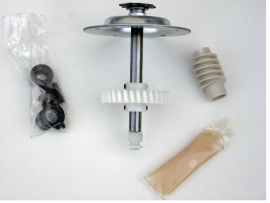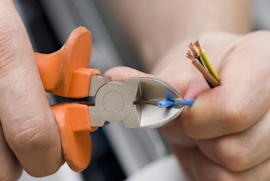How safe is your garage door opener?


It’s a good idea to periodically test whether your garage door opener’s safety system works as designed.
Just because the garage door opener moves the door up and down doesn’t mean it’s moving it safely and correctly. Here are a few simple tests to make sure your opener is working the way it should.
Check that the garage door moves freely
While your garage door is closed, disconnect the door from the opener drive mechanism by pulling the emergency release cord until it unhooks the connection latch.
Open and close the door; it should move smoothly and easily on the rollers in the tracks. If the door doesn’t glide freely, contact a professional for repairs.
Test the garage door opener’s auto-reverse
If the door passes the first test, reconnect the door to the opener drive mechanism and use the garage door opener to open the door completely.
To test the auto-reverse feature, lay a full roll of paper towels in its side on the ground, centered under the garage door. Use the garage door opener to close the door.
The door should come down onto the roll of towels, compress the roll and then automatically reverse direction. If the door doesn’t reverse direction when it compresses the roll or reverses before it compresses the roll, adjust the sensitivity control. You can find instructions in the owner’s manual for the garage door opener.
Test the sensors
To test the safety sensors, open the garage door and locate one of the sensors at the bottom of a door rail. Have a broom or something similar within reach.
Push the control button to close the garage door. Before the door closes fully, place the broom in front of one of the sensors to interrupt the invisible beam of infrared light from the sensor. Blocking the beam should cause the door to stop and reverse immediately. If the door doesn’t reverse, check the alignment of the sensors. If that doesn't fix the problem, some of the repairs in this video can help,
Most common symptoms to help you fix your garage door openers
Choose a symptom to see related garage door opener repairs.
Main causes: garage door opener misaligned, travel limits need adjustment, bad travel limit switches, faulty logic contr…
Main causes: garage door locked, damaged garage door tracks, up-force setting needs adjustment, RPM sensor failure, bad …
Main causes: safety sensor beams blocked, safety sensors not aligned, downforce setting needs adjustment, damaged garage…
Things to do: check garage door travel, tighten brackets and fasteners, test safety sensors, check travel limits and for…
Main causes: radio interference, weak remote batteries, sunlight interference with safety sensor beams, safety sensors n…
Main causes: faulty logic control board, bad RPM sensor, broken gears in the drive system, bad drive motor…
Main causes: neighbor's remote programmed at the same time as yours, faulty wall control wiring, bad wall control unit…
Main causes: loose fasteners, broken brackets, need preventive maintenance, worn drive gears, loose or worn belt, loose …
Most common repair guides to help fix your garage door openers
These step-by-step repair guides will help you safely fix what’s broken on your garage door opener.

How to replace a chain-drive garage door opener gear and sprocket assembly
Learn how to replace the gear and sprocket assembly on your garage door opener if the drive motor runs but the door won'…

How to replace a garage door opener logic board
The logic board is the brains of the garage door opener. If the remote doesn't work or the door doesn't open and close p…

How to replace a garage door opener drive chain and cable assembly
If your garage door won’t move, the chain and cable assembly on your garage door opener could be broken. Follow these st…
Effective articles & videos to help repair your garage door openers
Use the advice and tips in these articles and videos to get the most out of your garage door opener.

Learn about all the convenient features on our Sears PartsDirect website that make your parts purchases easier.…

Get answers to frequently asked questions about Sears and Sears PartsDirect.…

Learn how to repair broken, frayed or damaged wires in your appliances.…
